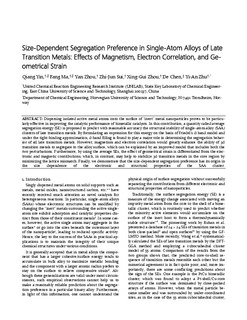Size-Dependent Segregation Preference in Single-Atom Alloys of Late Transition Metals: Effects of Magnetism, Electron Correlation, and Geometrical Strain
Journal article, Peer reviewed
Accepted version

Åpne
Permanent lenke
http://hdl.handle.net/11250/2639781Utgivelsesdato
2019Metadata
Vis full innførselSamlinger
Originalversjon
Journal of Physical Chemistry C. 2019, 123 (30), 18417-18424. 10.1021/acs.jpcc.9b03946Sammendrag
Dispersing isolated active metal atoms onto the surface of “inert” metal nanoparticles proves to be particularly effective in improving the catalytic performance of bimetallic catalysts. In this contribution, a quantity called average segregation energy (SE) is proposed to predict with reasonable accuracy the structural stability of single-atom alloy (SAA) clusters of late transition metals. By formulating an expression for this energy on the basis of Friedel’s d-band model and under the tight-binding approximation, d-band filling is found to play a major role in determining the segregation behavior of all late transition metals. On the other hand, magnetism and electron correlation would greatly enhance the ability of 3d transition metals to segregate to the alloy surface, which can be explained by an improved model that includes both perturbations. Furthermore, by using the average SEs, the effect of geometrical strain is differentiated from the electronic and magnetic contributions, which, in contrast, may help to stabilize 3d transition metals in the core region by minimizing the lattice mismatch. Finally, we demonstrate that the size-dependent segregation preference has its origin in the size dependence of the electronic and structural properties of SAA clusters.